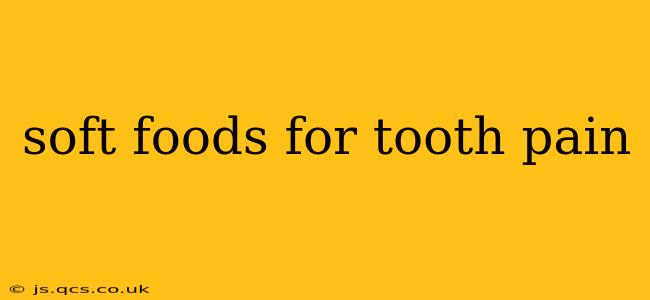Experiencing tooth pain can be incredibly debilitating, making even simple acts like eating a challenge. The good news is that a carefully chosen diet of soft foods can provide much-needed comfort while your mouth heals. This guide will explore the best options for soothing tooth pain, addressing common questions people have about nutrition during this challenging time.
What are the best soft foods for tooth pain?
The ideal soft food for tooth pain is one that requires minimal chewing and is gentle on sensitive gums and teeth. Think creamy, easily mashed, or already-soft textures. Here are some excellent examples:
-
Soups: Broth-based soups, creamy tomato soup, or pureed vegetable soups are all excellent choices. Avoid soups with chunky ingredients that could irritate your teeth.
-
Yogurt: Plain yogurt or yogurt with a little fruit puree is a nutritious and soothing option, providing calcium and probiotics beneficial for oral health.
-
Applesauce: Unsweetened applesauce is a great source of fiber and easy on the teeth.
-
Mashed Potatoes: Classic comfort food, mashed potatoes are easily digestible and gentle on sensitive areas. You can add a touch of butter or milk for extra creaminess.
-
Oatmeal: Cooked oatmeal, particularly creamy varieties, is a soothing and filling option. Avoid adding hard toppings like nuts or granola.
-
Scrambled Eggs: Softly scrambled eggs provide protein and are easy to swallow.
-
Smoothies: Blend fruits, vegetables, yogurt, and even protein powder for a nutritious and customizable meal replacement. Avoid adding ice unless it's finely crushed.
-
Bananas: Ripe bananas are naturally soft and easy to mash, providing potassium and other essential nutrients.
-
Avocado: Creamy avocado can be enjoyed on its own or mashed into other foods. It's rich in healthy fats.
What foods should I avoid with tooth pain?
Conversely, some foods should be strictly avoided while experiencing tooth pain. These include:
-
Hard Foods: Anything requiring significant chewing, like nuts, chips, hard candies, raw vegetables, and crusty bread, should be off the menu.
-
Acidic Foods: Citrus fruits, tomatoes (in their whole form), and vinegar-based dressings can irritate sensitive teeth and gums.
-
Sticky Foods: Sticky foods like caramel, toffee, and gummy candies can cling to your teeth, exacerbating pain and potentially causing further damage.
-
Extremely Hot or Cold Foods: Temperature extremes can increase sensitivity and pain.
-
Spicy Foods: Spicy foods can irritate already-inflamed gums and exacerbate pain.
Can I eat solid food with tooth pain?
This depends entirely on the severity of your toothache and the underlying cause. If you have a minor ache, you might be able to tolerate some softer solid foods. However, if the pain is intense, it's best to stick to soft foods until the pain subsides. Consult your dentist for guidance.
How long should I eat soft foods for tooth pain?
The duration of a soft food diet depends on the cause and severity of your tooth pain. A simple toothache might only require a few days of soft foods, while a more serious issue, like an extraction, may necessitate a longer period. Always follow your dentist's instructions.
What are some easy recipes for soft foods suitable for tooth pain?
Many simple recipes accommodate soft food needs. Consider blending soups, pureeing vegetables into sauces, or making creamy oatmeal with fruit. The key is to avoid any ingredients that require extensive chewing. You can find numerous soft food recipes online tailored for various dietary needs and preferences.
What are the nutritional considerations when eating only soft foods?
While soft foods provide temporary relief, relying on them for extended periods can lead to nutritional deficiencies. Ensure you're consuming a variety of soft foods to receive a balanced intake of nutrients. If you anticipate needing a soft food diet for more than a few days, consult a nutritionist or your doctor to ensure you're getting the nutrients you need.
Remember, consulting your dentist is crucial for determining the underlying cause of your tooth pain and receiving the appropriate treatment. This guide provides suggestions for managing discomfort; it does not replace professional dental advice.
